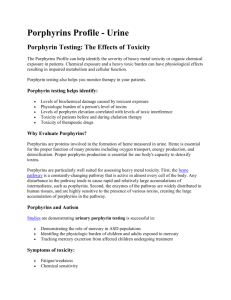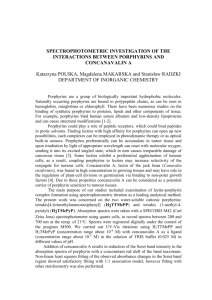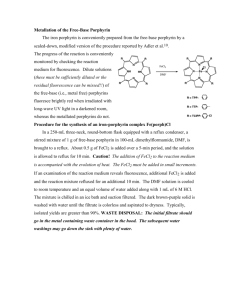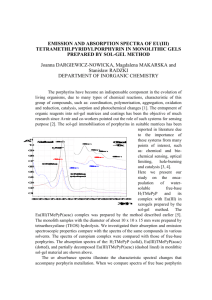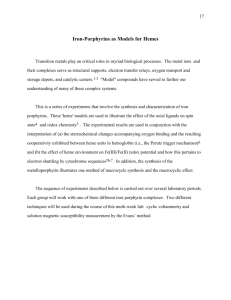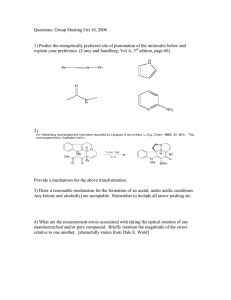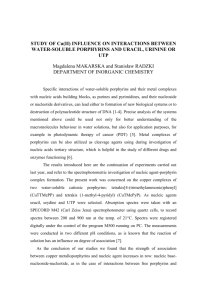Document 13461916
advertisement
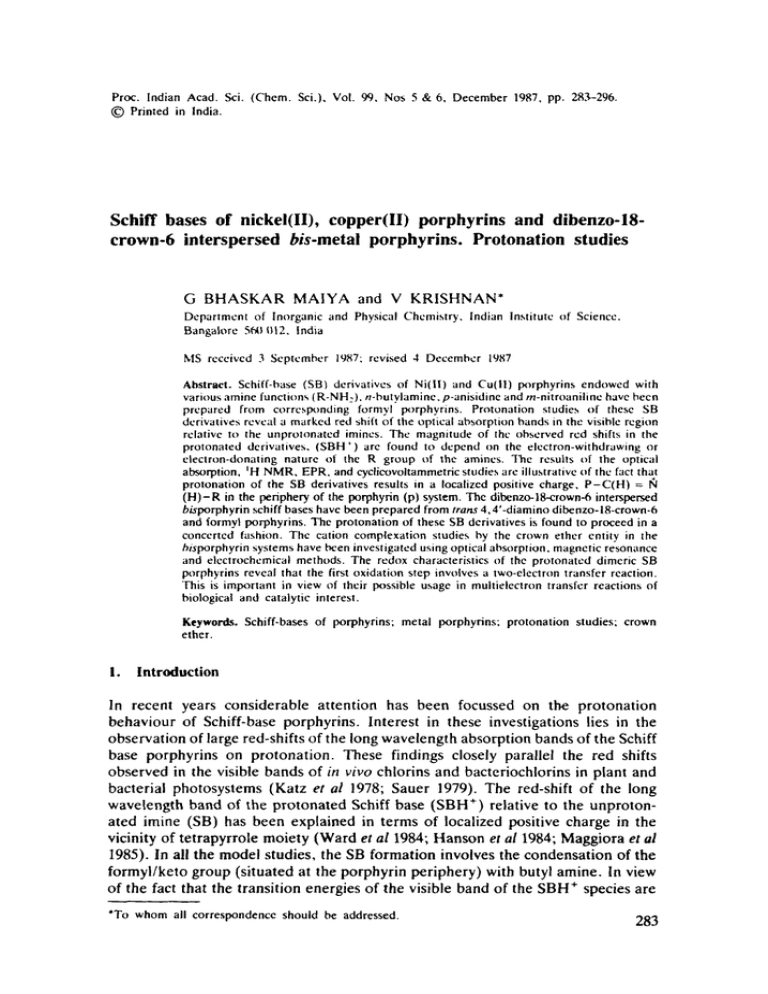
Pro<:. Indian Acad. Sci. (Chem. Sci.), Vol. 99, Nos 5 & 6, December 1987, pp. 283-296.
~ ) Printed in India.
Schiff bases o f nickel(IlL c o p p e r ( l l ) porphyrins and dibenzo-18crown-6 interspersed b i s - m e t a l porphyrins. Protonation studies
G BHASKAR MAIYA and V KRISHNAN*
Department of Inorganic and Physical Chemistry, Indian institute of Science.
Bangalore 56~()12. India
MS received 3 September 1987: revised 4 December 1987
Abstract. Schiff-base (SB) derivatives of Ni(ll) and Cu(ll) ix)rphyrins endowed with
various amine functions (R-NH_~). n-butylamine, p-anisidine and m-nitroanilinc have been
prcpared from corrcslxmding formyl porphyrins. Protonation studies of these SB
derivatives reveal a marked red ~hift of the optical absorption bands in the visible region
relative to the unprotonated imines. The magnitude of the observed red shifts in the
protonated derivatives, (SBH ~) arc found to depend on the electron-withdrawing or
electron-donating nature of the R group of the amines. The results of the optical
absorption, tH NMR, EPR, and cyclicovoltammetric studies are illustrative of the fact that
protonation of the SB derivatives results in a localized positive charge, P - C ( H ) = 1~1
( H ) - R in the periphery of the porphyrin (p) system. The dibenzo-18--crown-6 interspersed
b/sporphyrin schiff bases have been prepared from tram 4,4'-diamino dibenzo-18-crown-6
and formyl porphyrins. The protonation of these SB derivatives is found to proceed in a
concerted fashion. The cation complexation studies by the crown ether entity in the
bisporphyrin systems have been investigated using optical absorption, magnetic resonance
and electrochemical methods. The redox characteristics of the protonatcd dimeric SB
porphyrins reveal that the first oxidation step involves a two-electron transfer reaction.
This is important in view of their possible usage in multielectron transfer reactions of
biological and catalytic interest.
Keywords. Schiff-bases of porphyrins; metal porphyrins; protonation studies; crown
ether.
!.
Introduction
In recent years considerable attention has been focussed on the protonation
behaviour of Schiff-base porphyrins. Interest in these investigations lies in the
observation of large red-shifts of the long wavelength absorption bands of the Schiff
base porphyrins on protonation. These findings closely parallel the red shifts
observed in the visible bands of in vivo chlorins and bacteriochiorins in plant and
bacterial photosystems (Katz et al 1978; Sauer 1979). The red-shift of the long
wavelength band of the protonated Schiff base (SBH § relative to the unprotonated imine (SB) has been explained in terms of localized positive charge in the
vicinity of tetrapyrrole moiety (Ward et al 1984; Hanson et al 1984; Maggiora et al
1985). In all the model studies, the SB formation involves the condensation of the
formyl/keto group (situated at the porphyrin periphery) with butyl amine. In view
of the fact that the transition energies of the visible band of the SBH § species are
*To whom all correspondence should be addressed.
283
284
G Bhaskar Maiya and V Krishnan
affected by the extent of localization of the positive charge, it would be of interest
to study the influence of the nature of the amines (electron-withdrawing and
electron-donating) and metal ions on the optical absorption feature of the SBH +
species. Moreover, the covalently linked bisporphyrins bearing Schiff-base linkages
offer interesting models to probe into the changes in optical absorption features
that can occur from cooperative interactions of the two constituent monomeric
Schiff base units. In addition, these bisporphyrins provide an opportunity to study
the mutual metal-metal interactions and the influence of a positive charge (in the
periphery of SBH § on such interactions.
Here we report the synthesis and spectral properties of both monomeric and
dimeric Ni(ll) and Cu(ll) Schiff base porphyrins and their protonated derivatives.
The choice of Cu(II) and Ni(ll) porphyrins are necessitated by their inertness
towards demetallation. The SB porphyrins bear both aliphatic (butyl amine) and
aromatic (p-anisidine and m-nitroaniline) amines to study the effect of electrondonating and electron-withdrawing groups on the protonation behaviour and the
optical properties of the resulting SBH + species. Novel dimeric Ni(II) and Cu(ll)
porphyrin Schiff-bases wherein a crown ether, dibenzo-18-crown-6, moiety forms
the Schiff base covalent bridge between the two porphyrin units have been
prepared. In addition to investigating the possibility of step-wise protonation in
these bisporphyrins, we explored the utility of crown-ether interspersed bisporphyrins as ionophores. The optical absorption, ~H NMR and EPR spectral data of
these SB and SBH + species provide valuable information concerning the mode of
protonation of these SB porphyrins and their electronic structures.
2.
2.1
Experimental
Materials
Nickel(ll) and copper(lI) meso-tetraphenyl porphyrin aldehydes MTPP-CHO
were synthesised making use of the procedure of Momenteau et al (1979). The trans
4, 4'-diamino-dibenzo-18-crown-6 was prepared according to the earlier described
procedure (Thanabal and Krishnan 1981). The amines, n-butyl amine, p-anisidine
and m-nitroaniline were procured from Aldrich Chemicals (USA) and used as
received. All the solvents employed in the study were distilled and dried before
use. Representative preparation of Schiff-base porphyrins are given below.
2.1a Schiff base of NiTPP and p-anisidine: A solution containing 0-10 g of
NiTPP-CHO in 100 ml toluene and 0-20 g of p-anisidine dissolved in minimum
amount of CH3OH was refluxed for 4 h. At the end of this period, the solvent was
removed under reduced pressure and the residue was quickly washed with CH3OH
to remove the excess amine. The product was crystallized from CH3OH/CH2CI2
(1:1 by vol) solvent mixture.
2.1b Schiff base of NiTPP/CuTPP and diaminodibenzo-18-crown-6: To a 0.50 g
of CuTPP/NiTPP-(CHO) in 200 ml of toluene, 0-015 g of trans 4,4'-diaminodibenzo-18-crown-6 in 10 ml of CH~OH was added slowly over a period of 30 min.
This solution was refluxcd for 3 h and the solvent was removed under reduced
Protonation studies of porphyrins
285
pressure. The residue was washed with CH3OH several times to remove the
unreacted amine. The product was taken in CHCI3 and chromatographed on a
neutral alumina column. The dimer was obtained after elution with CHCI3.
The Schiff base complexes prepared in this study are shown in figure 1. The
yields in all the cases were about 10% based on the porphyrin-aldehyde. It is found
that repeated chromatography degrades the Schiff bases.
2.2
Methods
Schiff base protonation/deprotonation were performed according to the following
procedure. Air, equilibrated over concentrated HCI was bubbled through a 100 ml
solution of SB in CHCI3. The progress in protonation was monitored by following
the increase in absorbance at 620 nm. The protonation of SB is also accomplished
by successive addition of CF3COOH. The deprotonation reaction was carried out
either by bubbling air saturated with triethyl amine or by the addition of pyridine in
(a)
M = C u ( l l ) Ni ( l l )
R = -CHO
R=-C(H)= N-nBu
R=-C(H)=
R=-C(H)
~
--
Mla
MlbSB
N--~--OCH 3 ~
Mlc SB
= N--~
~
MldSB
NO2
(b)
()
"
11N.
N2
M : Ni ( I I ) ,
Cu(ll)
M2 SB
Figure l, The chemical structures of (a) monomeric, and (b) dimeric Schiff-base
complexes of Ni(ll) and Cu(ll) porphyrins.
286
G Bhaskar Maiya and V Krishnan
dry ether to the acidified solution of SB. Sufficient care was taken to avoid the
entrance of moisture when carrying out all the above reactions.
It is important to note that the features observed during the protonation/
deprotonation of dimeric SB porphyrins are essentially the same as that observed
for monomeric SB porphyrins. We have not been able to identify any monoprotonated form of the dimeric SB porphyrin. Spectroscopic and electrochemical
measurements were carried out on instruments described earlier (Bhaskar Maiya
and Krishnan 1985),
3.
Results and discussion
The SB derivatives of the metalloporphyrins have been synthesised from the
corresponding formyl compounds. The structural integrity of these compounds has
been established from the absorption spectral and ~H NMR data.
The absorption spectral profiles of CuTPP, CuTPP(CHO), and CulbSB in
CHCI.~ are shown in figure 2. It is observed that the Q bands of the porphyrins are
red-shifted on formylation. The porphyrin Schiff bases exhibit absorption bands at
shorter wavelengths relative to the formylated products. Dramatic changes in the
absorption spectral features of SB porphyrins are observed on protonation of these
compounds with CF3COOH/HCI. Successive addition of the acid to the SB
derivazives of Cu(ll) and Ni(ll) porphyrins results in very large spectral shifts of the
Q bands to the red region and a splitting/broadening of B bands (figure 3). The
absorption data of all SB porphyrins and their protonated analogues are given in
table 1. It can be seen that SBH + species [Ni(ll) and Cu(ll) derivatives of lc and
ld, and dimeric SB] endowed with aromatic side groups exhibit a larger red shift
(40 nm) of the Q bands relative to the SBH + compounds bearing aliphatic side
groups [Ni(II]/Cu(II)lbSB]. It is found that the magnitudes of these red shifts are
independent of the nature of the metal ion. This suggests that the changes in the
absorption profiles are due to the localized charges on the periphery of the
porphyrins and absence of any M-N (o- or ~- bond) interaction with the peripheral
charge. Significantly, addition of bases, pyridine or triethylamine, to the SBH +
species returns the original spectrum of SB indicating that the protonation is a
completely reversible process. It is of interest to note that the magnitude of the
spectral shifts and the shapes of the red-shifted bands observed on protonation of
the bisporphyrin Schiff-bases are not different from the corresponding monomeric
protonated Schiff bases. This implies that the protonation occurs in a concerted
fashion and the spectral changes are a consequence of the electronic structure of
the SBH + species. The origin of the spectral shifts in SBH + could be either due to
the delocalization of the positive charge on the ring or to the localization of the hole
on the periphery in an electron-deficient group in conjugation with the ring. In
order to investigate the effect of the latter, we synthesized an ethylcyanoacetate
adduct of CuTPP(CHO)/NiTPP(CHO) in which the substituent at the periphery of
the porphyrin is electron-withdrawing but coulombically neutral. The absorption
spectral features of these adduets closely resemble the features observed for SBH §
derivatives (table 1). This suggests that the charge in SBH + is localized on the
macrocycle. The presence of a positive charge in the porphyrin periphery can lead
to the lowering of the energy of the lr orbital of -C(H) = I~I (H)-R entity of SBH +
Protonation studies of porphyrins
287
causing a perturbation of rr' (e~,) orbitals of the porphyrin macrocycle resulting in
the red-shift of the Q bands of SBH +. These effects are investigated using magnetic
resonance spectroscopy.
The proton NMR spectra of NiTPP(CHO), NilcSB and the corresponding
SBH + in CDCI3 are shown in figure 4. It is found that all the proton resonances,
/3-pyrrole (8.90-8-60 ppm), o-mesoaryl (8-1X)-7-80 ppm) and m and p meso aryl
(7.78-7-60 ppm) groups of the porphyrin aldehyde are shifted marginally in the
corresponding Schiff bases. Of particular interest is the shift in the proton
resonance of NiTPP(CHO) at 9-20 ppm to 9.30 ppm on imine, -C(H) = N-R,
formation. The resonances originating from the R group are assigned based on
comparison with the resonance spectrum of NiTPP(CHO). We observed dramatic
changes in the proton resonances of SB on protonation. It is found that the
1.(
-
A
l!ili
~l
,
\
t |
"
~jS
9
sJ
I
400
%'~
I
I
500
600
Wavelength (nm)
700
Figure 2. Optical absorption spectral profiles of CuTPP(
), C u T P P C H O ( - - - ) and
CuIbSB( . . . . . ) in CHCI~ at 298 K. (A) The concentrations employed are 1.0 to 4-0 p.M.
(B) The concentrations employed are 0.l to 0-4 raM.
288
G Bhaskar Maiya and V Krishnan
1.0
q
aJ
t,=l
r-
s
0
r-~
.!
35O
/+50
550
650
Wavelength (nm)
750
Figure 3. Optical absorption spectral changes observed on successive addition of
CF3COOH to CulbSB in CHCI3 at 298 K. (a) CulbSB and (b) completely protonated
derivative Culb2SH". The concentration of CulbSB employed is 1-0-2.0 t~M.
resonances of the protons close to the positive charge, -C(H) = I(I (H)R, are
progressively shifted to higher fields and broadened. On the other hand, the
/3-pyrrole and meso aryl proton resonances occur around the same field as that
observed for the SB indicating that these protons are less affected by protonation.
Interestingly, the proton bonded to the carbon in -C(H) = gl (H)R resonates in
the upfieid region relative to its position at 9.30 ppm in the SB. We ascribe this to
the shielding effect induced on protonation and to the zr-electron anisotropy
experienced by the - C ( H ) = 1~I( H ) - R group. It is noteworthy that the presence of
a positive charge on the nitrogen of the SBH § results in the deshielding and
broadening of the proton resonances of the R group. The latter decreases with
increasing distance between the positive charge and the R group. These findings
Protonation studies of porphyrins
289
Table I. Visible spectral data o n Schiff-base complexes and
their protonated species in CHCI~ at 298 K".
,~(nm)
Compound
Q,
Q2
B.
CuTPP
58(1
590
580
628
587
643
587
648
587
646
573
576
575
615
5811
638
583
6.411
580
6511
667
541
551
545
417
429
419
452
425
476
431
476
425
474
416
428
422
446
426
472
429
475
427
475
448
Cula
CulbSB
Cu IbSBH"
CulcSB
Cu I c S B H '
CuldSB
Cu IdSBH+
Cu2SB6
Cu2SBH+ "
NiTPP
Nila
Ni I bSB
NilbSBH"
Ni IcSB
Ni IcSBH +
NildSB
Ni I d S B H '
Ni2SBb
Ni2SBH ' b
Ni-ethyl cyano
acetate adduct
549
547
549
528
538
536
5411
541
537
B,
387
397
396
394
3811
3thJ
395
380
~' Protonation was achieved by adding tlCI or CF~COOH:
h Addition of Cs + to these dimeric porphyrins dc~es not alter
the spectral features.
collectively show that the protonation of the SB is similar to the effect of cleating
an exceptionally strong electron-withdrawing group in the periphery of the
macrocycle.
It would be of interest to study whether there exists any electronk oupling of the
7r-systcm and the peripheral positive charge. The Schiff bases of Cu(ll) porphyrins
are chosen to study these effects using EPR spectroscopy. The EPR spectra of
CuldSB and the corresponding SBH § in tolucne at 100 K are shown in figure 5.
The spectra were analysed using the spin Hamiltonian for axial symmetry (Assour
1965). The values of g and A tensors have been calculated for all the monomeric
and dimeric SB derivatives, and their corresponding protonated species (table 2). It
is found that the EPR spectral features of SB and SBH + species are similar and the
magnitudes of the g and A values do not markedly change in SB and in the
protonated SBH + complexes. These two observations indicate that the hole
created at the porphyrin periphery is not electronically coupled with the 7r-system
so as to create a perturbation at the Cu(ll) centre. This also suggests the absence of
any Cu(ll)-Cu(il) interaction in the crown ether interspersed dimeric Schiff base
derivatives of Cu(ll) porphyrins (Thanabal and Krishnan 1982). The possibility of
axial coordination of thc added proton donors CF~COOH/HCI to the Cu(ll) centre
is discarded since the g and A values do not increase in the SBH + species relative to
290
G Bhaskar Maiya and V Krishnan
9
"V"
7
8
X
(b)
/
I
I
9
7
X
(c)
1
9
1
8
7
6(ppm)
Figure 4. The t}-I NMR spectra of In) NiTPPCHO. (b) NilcSB and le) NilcSBH'
in CDCI~ at 298 K. NilcSBH' is produced on addition of CFaCOOH to NilcSB. Solvent
impurity peaks are marked X.
those observed for the corresponding SB (Chandrashekar and Krishnan 1981.
1982). The marginal changes in EPR parameters in SBH + relative to SB can be
ascribed to the inductive effects of the peripheral electron-withdrawing group.
-C(H) = I~ (H)-R.
It is known that the redox properties of the porphyrins are strongly influenced by
the electron-donating or -withdrawing nature of the substituents (Felton 1978). The
cyclic voltammograms (CV) of the various SB and their protonated complexes have
been studied to elucidate the effect of the substituents on the redox potentials. The
CV of CulbSB and its derivatives in the anodic region are shown in figure 6. The
two reversible peaks observed in the region 0-1.5(} V correspond to the successive
one-electron transfers from the porphyrin ring. This is confirmed by the analysis of
291
Protonation studies of porphyrins
~g•
(eL)
~g.
-
(b)
,lg,!
~gJ.
Figure 5. EPR spectra of (a) C u l d S B , and (b) C u l d S B H '
C u l d S B H ' is produced by addition of HCI to CuldSB.
in toluene at 100 K.
Table 2. EPR data on ( ' u ( l l ) derivatives of Schiff-base complexes and their protonatcd analogucs in toluene at I(Xl K.
CuTPP
Cula
CulbSB
CuibSBH'
CulcSB
CulcSBH'
CuldSB
Cu IdSBtl '
Cu2SB
('u2SBtt' '
C u 2 S B H ' + Cs"
gl~
g0
2-185
2.152
2-167
2.173
2.157
2.16tl
2-158
2. 159
2.138
2.1611
2.13b;
2-1147
2.(113
2.(129
2.023
2.(122
2.112(I
2.020
2.024
1.9019
2.1119
1.985
( x 11}-4 c m - " )
208.0
196.0
198.(I
198-11
2(11.0
2115.0
2(k).0
201-0
2117.(I
9
2(17.0
31.5
31.(I
31-9
31.I
31.3
30.(I
31-2
31.2
31.1
31.4
311.8
14.8
14.3
14.3
14.4
14.3
14.6
14.3
14.4
15.(I
9
15.1
16-11
15.5
16.0
15.7
15.5
15.4
15.6
15.5
15.6
15.7
15.7
" Spectra were taken in CH3OH: (.'H2CI a ( I : I. V/V) solvent mixture: * Spectrum
is not well resolved to calculate these values.
292
G Bhaskar Maiya and V Krishnan
(Q)
o.,I
t..
S:l
k.../
I
1.6
I
I
1.2
0'8
Voltage (volts)
I
0'4
(b)
r
U
I
I
I
1
1.6
1.2
0.8
0.6
V o l t o g e (volts)
F i b r e 6, Cyclic v o l t a m m o g r a m s of ( a ) C u l b S B , and ( b ) C u I b S B H § in Ctt2CI 3
containing 100 m M T B A P at 298 K. Scan rate 5(1 mV/s. C u l b S B H § was p r o d u c e d on
addition of C F ~ C O O H to C u I b S B . Potentials arc with respect to S C E .
current-voltage profiles at different scan rates. The electrochemical data obtained
for all other Cu(ll) and Ni(ll) derivatives are given in table 3. An inspection of the
table reveals that the SB porphyrins exhibit ring oxidation potentials in a lower
anodic region relative to that of the porphyrin-aldehyde, while on protonation, the
SBI-t + species exhibit ring oxidation at a higher anodic potential relative to the SB.
This shows that the addition of acid renders the electron removal from the
porphyrin more difficult suggesting that the -C(H) = I~1 (H)-R group situated at
the periphery of the porphyrin is indeed a strong withdrawing group.
The electrochemical redox data has provided information on the relative energy
difference between the HOMO and the LUMO in the various synthesized
porphyrin aldehydes, Schiff bases and their corresponding protonated species. The
difference between the first oxidation potential and the reduction potential of the
porphyrin ring can be approximated to the energy difference betwen the HOMO
and the LUMO in the porphyrins (Fuhrhop 1974). It is observed that the energy
difference between the HOMO and the LUMO in the SB porphyrins are
marginally higher than the porphyrin aldehydes. This affords an explanation of the
blue shift of the Q bands observed on SB formation. It was earlier suggested that in
the SBH + species, there is considerable mixing of the ~r" orbital of the substituent
with the eg ('n-') orbital of the porphyrin ring leading to the stabilization of the latter
orbital. This suggests that the reduction of the substituent group should occur at a
higher cathodic potential relative to the free state. Though we are unable to probe
into the reduction of the substituent electrochemistry, the trend in the oxidation
293
Protonation studies o f porphyrins
T a b l e 3. R c d o x pt~tentials of Schiff-ba~,e and t h c i r p r o t o n a t c d c o m p l e x e s
in C H , C I , at 298 K'.
Compound h
CuTPP
Cula
CulbSB
CulbSBtI'
CulcSB
CulcSBH"
CuldSB
CuldSBH'
Cu2SB
Cu2SBII'
NilPP
Nil:t
NilbSB
NilbSBH'
Ni I cSB
Ni I eSBI I +
NildSB
NildSBII'
Ni2SB
Ni2SBH+
P--P'
.I)1
.11~
.15
.1~
.14
.lb
.16
.28
.(11
11.94'
.18
.15
-19
-23
-25
.26
-25
-21
1-19
1.12'
V
P+'--
P-", V
1.26
1-32
1-38
1-36
1-45
P--P
" V
- 1.29
- 1.11
- 1.26
- 1.21
1-49
1-37
- 1-16
1-43
1-35
- 1-19
-
1.21
-
1. I()
-
1.22
-
1.26
-
1.22
-
1.2(I
-
I-16
'9 P o t e n t i a l s are r e p o r t e d with respect to S C E . E r r o r : _+ 2(1 inV.
P, P + ' , P-'+ and P " refer to n e u t r a l , m o n o c a t i o n radical+ d i c a t i o n and
m o n o a n i o n radical species of the c o r r e s p o n d i n g p o r p h y r i n s , r e s p e c t i v e l y .
L R e p r e s e n t s t w o - e l e c t r o n transfer.
potentials of the SBH + species indicate that the energy differences between the
HOMO and the LUMO are lower than in the corresponding SB porphyrins. This
provides an explanation of the red shift of the Q bands observed for SBH + species.
Of special interest is the electrochemical behaviour of dimeric SBH + derivatives
of Cu(ll) porphyrins. Earlier studies on his Cu(II) systems reveal that the
Cu(II)-Cu(II) interactions are easily manifested in the magnitudes of the
oxidation/reduction potentials (Collman et al 1979; Liu et al 1983). The CV of the
his Cu(II) derivative, Cu2bSB, in CH2CI2 exhibits a reversible peak (figure 7) at
1-01 V involving one-electron oxidation of the porphyrin ring. This shows that the
porphyrin rings are essentially non-interacting in the bis Cu(II) derivatives
(Collman et al 1980; Leznoff et al 1984). Interestingly, on protonation, the SBH 2+
species exhibit a potential at 0.94 V involving a two-electron oxidation in contrast
to the one-electron oxidation of the corresponding non-protonated Schiff base
(figure 7). This seems to suggest that the presence of a positive charge on the
periphery of the porphyrins in the bis Cu(ll) derivatives possibly alters the
mechanism of heterogenous electron transfer (Nichoison 1965). We believe that
the two porphyrin rings in the dimer respond to oxidation independently and that
the interaction between them is weak since the two rings are separated by more
than 10 t~, and the covalent bridge that exists between them is conformationally
rigid.
In our earlier studies, we demonstrated the utility of cavity-bearing porphyrins as
efficient ionophores (Dasgupta et al 1982). We investigated the ionophore
294
G Bhaskar Maiya and V Krishnan
(all
I5pA
k.
L.)
1
1.6
I
1
1.2
0.8
Voltage (volts)
I
0-z,
Figure 7. Cyclic voltammograms of (a) Cu2bSB, and (b) Cu2bSBH]*, in CH2CIz
containing 100 mM TBAP at 298 K. Scan rate 50 mVls. SBHzz§ was produced on addition
of CF~COOH to SB. Potentials are with reference to SCE.
behaviour of bisCu(ll)/Ni(ll) porphyrins bearing a dibenzo-18-crown-6 cavity. Of
special importance is the study of the complexation behaviour oi bisporphyrins with
those cations which require two dibenzo-18-crown-6 cavities, since the cation
encapsulation can result in the dimeric derivatives of the b/s Cu(lI)/Ni(II) porphyrins
similar to the cation-induced dimers of crown ether porphyrins (Thanabal and
Krishnan 1982). It is known that the Cs + ion forms 1:2 (cation : dibenzo-18-crown6) complexes with crown ether (Pedersen 1967). It is observed that the addition of
CsCI/CsCNS solution (CH3OH : CHCI3 1:1 by vol) to the Cu2SB/Ni2SB or their
protonated derivatives in the same solvent mixture does not produce any shifts in Q
or B absorption bands of the porphyrins. However, the IH NMR spectra of a
solution containing Ni2SB/Ni2SBH 2+ in CD3OD/CD3CN and Cs + ion reveal
broadening of the proton resonances of the ether fragments in the region
3.00-4.(XI ppm suggesting Cs + complexation with the crown ether (Live and Chan
1976). Owing to poor resolution of the IH N M R spectrum, it is difficult to assess
the extent of complexation in these systems. We investigated the E P R spectra of
Cs + complexes of C u 2 S B H / C u 2 S B H e+ in toluene at 100 K in the anticipation of
detecting axial dimers of b/s Cu(lI) SB and its promoted derivatives. The E P R
parameters of the Cs + complexes reveal no significant change in g and A tensor
values and show the absence of Am = + 2 transitions. This indicates that the
complexation of Cs + ion does not result in dimers of his Cu(II) SB derivatives
possessing axial symmetry. The presence of Cs + ion in the dibenzo-18-crown-6
cavity of the b/s Cu(lI)/Ni(lI) SB porphyrins and their protonated species does
not alter the ring oxidation/reduction potentials of these porphyrins. It is of interest
to note that the oxidation potentials of Cs + complexes of protonated derivatives
involve a two-electron process. The Cs § complexes of these porphyrins, though
formed in solution, do not exhibit any marked changes in the spectral features. This
can be due to two reasons: (i) the effect of ion-dipole (of the ether oxygens)
interactions are not transmitted to the porphyrin zr-manifold because of large
distance and/or absence of conjugation to the ring and (ii) the dimers of the b~
Protonation studies of porphyrins
295
Cu(lI)/Ni(II) SB porphyrins as a consequence of Cs + ion complexation do not
possess the axial symmetry, and/or the distance between the two bisporphyrins in
the dimer are very large.
4. Conclusions
It is shown that protonation of the Schiff-base derivatives of Ni(II) and Cu(ll)
porphyrins endowed with various amines, R-NH2, with varying R produces a
red-shift of 40 nm in the Q bands of the porphyrin. The observed red-shift in these
model compounds are analogous to the shift observed between the in vivo and in
vitro chlorophyll molecules. This suggests that the structurally modified porphyrins
form viable alternatives to the special-pair model of P680 in plant-bacterial
photosynthetic systems. It is reasonable to assume that a protein residue can enter
Schiff base formation with a formyl/keto group of the tetrapyrrole derivatives of
P680. Protonation of this can lead to the observed red-shift in the primary donor in
P680 relative to the isolated in vitro monomeric pigments. It is recognized that the
plant pigments possess Mg ions in the macrocycle and the in vitro studies containing
Mg ions are sensitive to demetailation on protonation. Moreover, the pigments
bearing Mg are fluorescent while the Cu(ll)/Ni(ll) derNatives reported here are
non-fluorescent. Interestingly, however, the observed two-electron oxidations in
the protonated b/s-Cu(ll)SB porphyrins is encouraging in view of the recent studies
in the search for multielectron catalytic systems of biological interest.
It is illustrated that the red-shift in the Q bands observed for the protonated SB
derivatives essentially arise from the localized positive charge, (-CH=glHR), in
the periphery of the macrocycle. Several lines o! evidence have been presented for
the non-interacting positive charge in these systems. We demonstrate here that the
Schiff base formation need not necessarily arise from formyl porphyrins (where the
formyl group is situated in one of the ,8-pyrrole rings) and an amine. Instead, a
porphyrin amine, mono p-aminophenyl triphenyl porphyrin can be used for SB
formation with benzaldehvde. The protonation of the latter leads to the red-shifts
of the Q bands similar to that observed in the formyl-porphyrin Schiff bases
(unpublished). This shows that the presence of a positive charge in any remote position
can lead to the red shifts of the Q bands, arising from the perturbation/mixing of
the ~'* orbital of the substituent with the LUMO of the porphyrins.
Acknowledgements
This work is being supl:x)rted by grants from the Department of Science and
Technology, Government of India, New Delhi, and the Indian National Science
Academy, New Delhi. The authors are thankful to these authorities for the
funding.
References
Assour J M 1965 ( h e m . Ph~,'s. 43 2477
Bha,kar Maiya G and Krishnan V 1985 ]. Phv,~. ('hem. 69 5225
C h a n d r a s h c k a r 3 K and Krishnan V 1981 J, Inorg, Nuct. ('hem, 43 2387
296
G Bhaskar Maiya and V Krishnan
Chandrashekar T K and Krishnan V 1982 h~org. Chim. AcIu 62 259
('otlman J P. Marroceo M. Denise~ich P, Koval C and Anson F C 1979 J. Electroanal. Chem. 101 117
Collman J P, Dcnisevich P. Konai Y. Marroceo M. Koval C and Anson F C 1980J. Am. Chem. Sot. 102
~127
Dasgupta D, Thanabal V and Krishnan V 1982 Biochem. Bi~phys. Res. ('ommun. 104 1427
Fclton R H 1978 in The porphyrin.s (Dolphin edn.) (New York: Academic Press) vol. 5, p. 3
Fuhrhop J H 1974 Struct. Bonding (Berlin) 18 1
Hanson I. K, Chang C K, Ward B, Callahan P M, Babcock G T and Head J D 1984 J. Am. ('hem. ,~oc.
106 3950
Katz J J, Norris J R, Shipman L L, Thunhaver M C and Wa,,,ielewskii M R 1978 Annu. Rev. Biophys.
Bioeng. 7 393
Liu H Y, Weaver M J. Wang C B and Chang C K 1983 J. Elecmmnal. Chem. 145 439
Live D and Chan S I 1976 J. Am. Chem. Sot'. 98 3769
Leznoff C C, Greenbcrg S. Marcuccio S M, Minor P C. Seyunour P and Lever A B P 1984 Inorg. Chim.
Acta 89 L35
Maggiora L L, Pctke J D, Gopal D, lwamoto R T and Maggiora G M 1985 Photochem. Photohiol. 42 69
Momenteau M, Loock B. Bisagni E and Rongee M 1979 Can. J. Chem. 57 1804
Nicholson R S 1965 Anal. Chem. 37 1351
Pederson C J 1967 J. Am. Chem. Soc. 89 7017
Sauer K 1979 Annu. Rev. Phys. (Twrn. 30 155
Thanabal V and Krishnan V 1981 Svnth. React. Inorg. Met.-Org. Chem. II 659
Thanabal V and Krl.,,hnan V 1982 Inore. Chem. 21 361h5
Ward B, (7hang C K and Young R 1084 J. Am. ('hem. Soc. 106 3943
